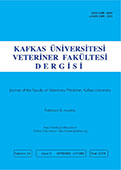
This journal is licensed under a Creative Commons Attribution-NonCommercial 4.0 International License
Kafkas Üniversitesi Veteriner Fakültesi Dergisi
2018 , Vol 24 , Issue 5
Effect of Different Dietary Lysine Regimens on Meat Quality Attributes in Varieties of Indigenous Aseel Chicken
1Department of Zoology, University of the Punjab, Lahore, 54000, PAKISTAN2Department of Poultry Production, Faculty of Animal Production and Technology, University of Veterinary and Animal Sciences, Lahore, 54000, PAKISTAN DOI : 10.9775/kvfd.2018.19523 This study was planned to evaluate the effect of different dietary lysine regimens on sensory attributes and meat quality in Lakha, Mianwali, Mushki and Peshawari varieties of indigenous Aseel. A total of 240 day-old chicks, 60 per each variety were casually selected and sub-divided equally into A, B and C groups. Three lysine regimens namely L1, L2 and L3 were offered to these birds, L1 comprising of 1.3% lysine was served from 0-6th week to birds of group A, and L2 constituting1.4 and 1.2% lysine, where 1.4% lysine from 0-3rd week and 1.2% lysine from 4-6th week was offered to group B. L3 having 1.5, 1.3 and 1.1% lysine was offered as 1.5 from 0-2nd, 1.3 from 3-4th and 1.1% lysine from 5-6th week, respectively to group C. For evaluation of organoleptic and meat quality traits, 72 birds counting 18 per each variety were randomly selected and slaughtered. The breast and thigh meat pieces were separated and their pH was determined at various intervals. The cooked meat color, taste, flavor, tenderness and juiciness were checked to calculate overall acceptability of panelists on nine hedonic scale points between extreme liking and disliking. The findings of this study revealed L3 lysine regimen to be the best for nourishing the birds having good quality meat with respect to color, taste, flavor tenderness, juiciness and overall acceptability towards its consumers. Keywords : Aseel varieties, Lysine regimens, Meat quality, Meat pH, Sensory attributes










